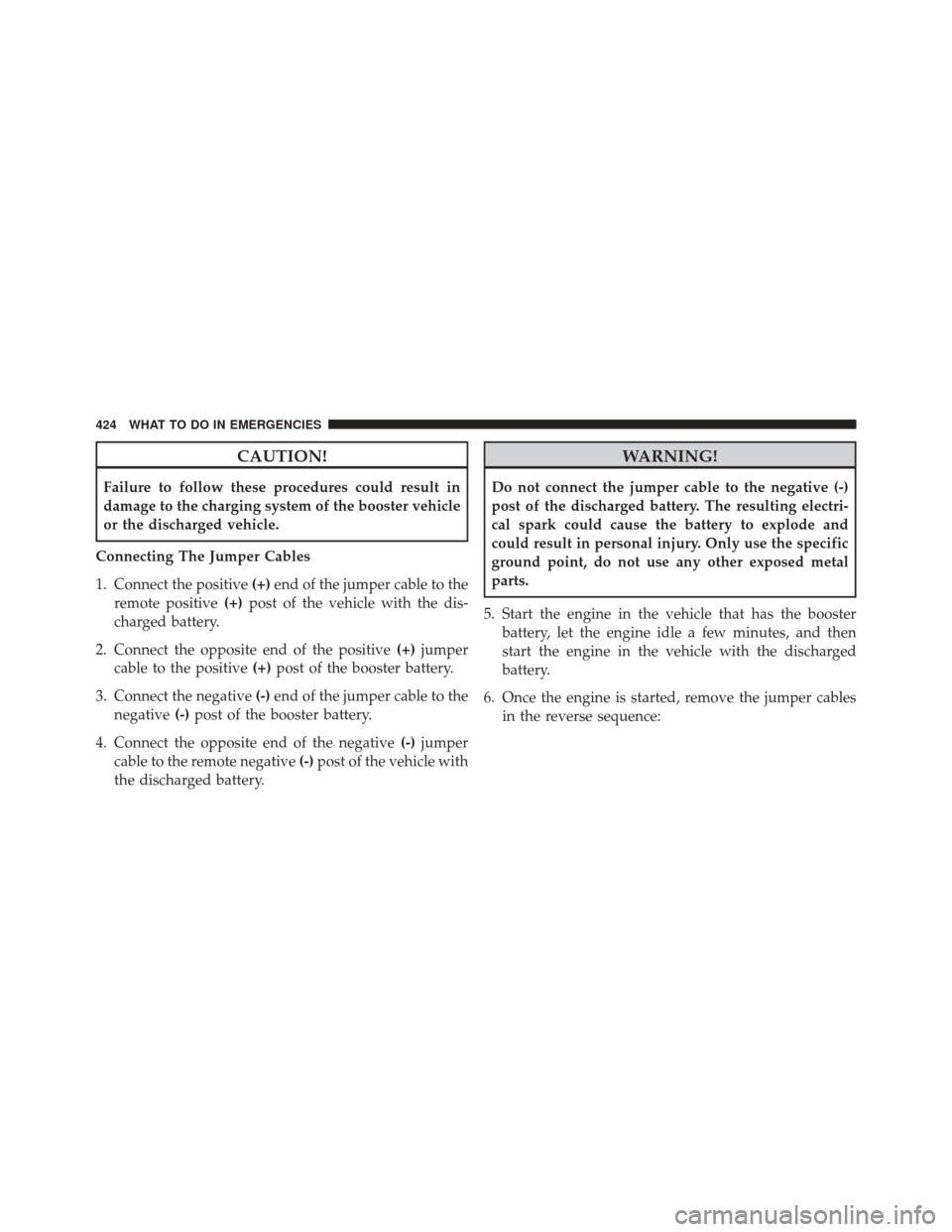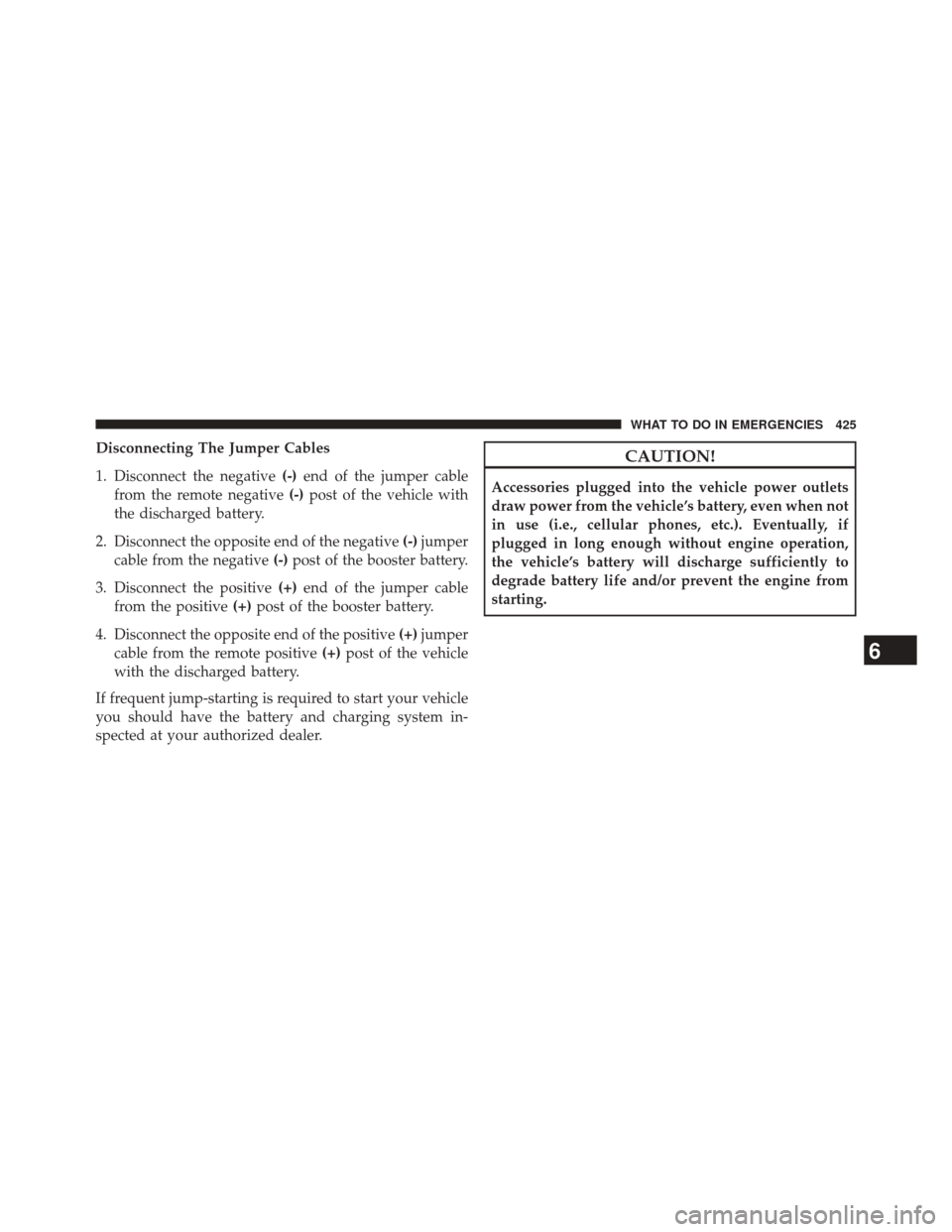Page 424 of 539
CAUTION!
Do not use a portable battery booster pack or any
other booster source with a system voltage greater
than 12 Volts or damage to the battery, starter motor,
alternator or electrical system may occur.
WARNING!
Do not attempt jump-starting if the battery is frozen.
It could rupture or explode and cause personal injury.
Preparations For Jump-Start
The battery is stored under an access cover in the trunk.
Remote battery posts are located on the right side of the
engine compartment for jump-starting.
Remote Battery Posts Locations
1 — Remote Positive(+)Post
2 — Remote Negative (-)Post
422 WHAT TO DO IN EMERGENCIES
Page 425 of 539

WARNING!
•Take care to avoid the radiator cooling fan when-
ever the hood is raised. It can start anytime the
ignition switch is ON. You can be injured by
moving fan blades.
• Remove any metal jewelry such as rings, watch
bands and bracelets that could make an inadvertent
electrical contact. You could be seriously injured.
• Batteries contain sulfuric acid that can burn your
skin or eyes and generate hydrogen gas which is
flammable and explosive. Keep open flames or
sparks away from the battery.
1. Set the parking brake, shift into PARK (automatic transmission) or 1st gear (manual transmission) and
turn the ignition to LOCK.
2. Turn off the heater, radio, and all unnecessary electri- cal accessories. 3. If using another vehicle to jump-start the battery, park
the vehicle within the jumper cables reach, set the
parking brake and make sure the ignition is OFF.
WARNING!
Do not allow vehicles to touch each other as this
could establish a ground connection and personal
injury could result.
Jump-Starting Procedure
WARNING!
Failure to follow this jump-starting procedure could
result in personal injury or property damage due to
battery explosion.
6
WHAT TO DO IN EMERGENCIES 423
Page 426 of 539

CAUTION!
Failure to follow these procedures could result in
damage to the charging system of the booster vehicle
or the discharged vehicle.
Connecting The Jumper Cables
1. Connect the positive (+)end of the jumper cable to the
remote positive (+)post of the vehicle with the dis-
charged battery.
2. Connect the opposite end of the positive (+)jumper
cable to the positive (+)post of the booster battery.
3. Connect the negative (-)end of the jumper cable to the
negative (-)post of the booster battery.
4. Connect the opposite end of the negative (-)jumper
cable to the remote negative (-)post of the vehicle with
the discharged battery.
WARNING!
Do not connect the jumper cable to the negative (-)
post of the discharged battery. The resulting electri-
cal spark could cause the battery to explode and
could result in personal injury. Only use the specific
ground point, do not use any other exposed metal
parts.
5. Start the engine in the vehicle that has the booster battery, let the engine idle a few minutes, and then
start the engine in the vehicle with the discharged
battery.
6. Once the engine is started, remove the jumper cables in the reverse sequence:
424 WHAT TO DO IN EMERGENCIES
Page 427 of 539

Disconnecting The Jumper Cables
1. Disconnect the negative(-)end of the jumper cable
from the remote negative (-)post of the vehicle with
the discharged battery.
2. Disconnect the opposite end of the negative (-)jumper
cable from the negative (-)post of the booster battery.
3. Disconnect the positive (+)end of the jumper cable
from the positive (+)post of the booster battery.
4. Disconnect the opposite end of the positive (+)jumper
cable from the remote positive (+)post of the vehicle
with the discharged battery.
If frequent jump-starting is required to start your vehicle
you should have the battery and charging system in-
spected at your authorized dealer.CAUTION!
Accessories plugged into the vehicle power outlets
draw power from the vehicle’s battery, even when not
in use (i.e., cellular phones, etc.). Eventually, if
plugged in long enough without engine operation,
the vehicle’s battery will discharge sufficiently to
degrade battery life and/or prevent the engine from
starting.
6
WHAT TO DO IN EMERGENCIES 425
Page 438 of 539
ENGINE COMPARTMENT — 3.6L
1 — Remote Jump Start (Positive Battery
Post)4 — Engine Oil Dipstick
7 — Air Cleaner Filter
2 — Power Distribution Center (Fuses) 5 — Brake Fluid Reservoir Access Cover 8 — Engine Oil Fill
3 — Remote Jump Start (Negative Battery
Post) 6 — Engine Coolant Reservoir
9 — Washer Fluid Reservoir
436 MAINTAINING YOUR VEHICLE
Page 439 of 539
ENGINE COMPARTMENT — 5.7L
1 — Remote Jump Start (Positive Battery
Post)4 — Brake Fluid Reservoir Access Cover 7 — Engine Oil Fill
2 — Power Distribution Center (Fuses) 5 — Engine Coolant Reservoir 8 — Engine Oil Dipstick
3 — Remote Jump Start (Negative Battery
Post) 6 — Air Cleaner Filter
9 — Washer Fluid Reservoir7
MAINTAINING YOUR VEHICLE 437
Page 449 of 539
Engine Air Cleaner Filter Selection
The quality of replacement engine air cleaner filters
varies considerably. Only high quality filters should be
used to assure most efficient service. MOPAR® engine air
cleaner filters are a high quality filter and are recom-
mended.
Maintenance-Free Battery
Your vehicle is equipped with a maintenance-free battery.
You will never have to add water, nor is periodic main-
tenance required.
NOTE:The battery is stored under an access cover in the
trunk. Remote battery terminals are located in the engine
compartment for jump-starting. Refer to “Jump-Starting
Procedures” in “What To Do In Emergencies” for further
information.
Battery Location
7
MAINTAINING YOUR VEHICLE 447
Page 522 of 539

DisposalAntifreeze (Engine Coolant) ................460
Door Locks Door Locks ............................33
KeyFob...............................33
Remote ...............................33
Remote Keyless Entry (RKE) ................33
Door Locks, Automatic ......................35
Door Opener, Garage ...................... .185
Driving Through Flowing, Rising, or Shallow Standing
Water ............................... .317
Driving to Achieve Maximum Fuel Economy ......227
Electrical Power Outlets .....................197
Electric Remote Mirrors .....................111
Electronic Brake Control System ...............327
Electronic Power Distribution Center (Fuses) ......478
Electronic Speed Control (Cruise Control) ........172Electronic Stability Control (ESC)
..............331
Electronic Throttle Control Warning Light ........211
Electronic Vehicle Information Center (EVIC) ......221
Emergency Deck Lid Release ..................44
Emergency, In Case of Freeing Vehicle When Stuck ................426
Hazard Warning Flasher ..................399
Jacking .............................. .412
Jump Starting ......................... .421
Overheating .......................... .399
Towing ............................. .429
Emergency Trunk Release ....................44
Emission Control System Maintenance ..........439
Engine ................................ .437
Air Cleaner .......................... .446
Block Heater ......................... .299
Break-In Recommendations .................96
Checking Oil Level ..................... .442
Compartment ......................... .436
520 INDEX